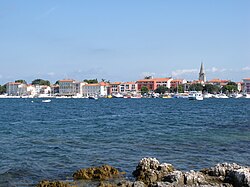Poreč
| Poreč/Parenzo | ||
|---|---|---|
| City | ||
|
Grad Poreč - Città di Parenzo City of Poreč/Parenzo |
||

Poreč/Parenzo harbor
|
||
|
||
| Location of Poreč/Parenzo within Croatia | ||
| Coordinates: 45°13′N 13°35′E / 45.217°N 13.583°ECoordinates: 45°13′N 13°35′E / 45.217°N 13.583°E | ||
| Country |
|
|
| County |
|
|
| Government | ||
| • Mayor | Edi Štifanić (IDS) | |
| Area | ||
| • Total | 139 km2 (54 sq mi) | |
| Elevation | 29 m (95 ft) | |
| Population (2011) | ||
| • Total | 16,696 | |
| Time zone | CET (UTC+1) | |
| • Summer (DST) | CEST (UTC+2) | |
| Postal code | 52 440 | |
| Area code(s) | 052 | |
| Website | porec.hr | |
Poreč/Parenzo (Latin: Parens or Parentium; Italian: Parenzo; Ancient Greek: Πάρενθος Pàrenthos) is a town and municipality on the western coast of the Istrian peninsula, in Istria County, Croatia. Its major landmark is the 6th century Euphrasian Basilica, which in 1997 was designated a UNESCO World Heritage Site.
The town of Poreč/Parenzo is almost 2,000 years old, and is set around a harbor protected from the sea by the small island of Sveti Nikola/San Nicola (Saint Nicholas). The town's population of approximately 12,000 resides mostly on the outskirts, while the wider Poreč/Parenzo area has a population of approximately 17,000 inhabitants. The municipal area covers 142 square kilometres (55 sq mi), with the 37 kilometres (23 miles) long shoreline stretching from the Mirna River near Novigrad/Cittanova to Funtana and Vrsar/Orsera in the south. Ever since the 1970s, the coast of Poreč/Parenzo and neighboring Rovinj has been the most visited tourist destination in Croatia.
This area has been inhabited since prehistoric times. During the 2nd century BC, Roman Castrum was built on a tiny peninsula with approximate dimensions of 400 m × 200 m (1,312.34 ft × 656.17 ft) where the town centre is now. During the reign of Emperor Augustus in the 1st century, it officially became a city and was part of the Roman colony of Colonia Iulia Parentium. In the 3rd century the settlement had an organized Christian community with an early-Christian complex of sacral buildings. The earliest basilica contained the remains of and was dedicated to Saint Maurus of Parentium and dates back to the second half of the 4th century. The floor mosaic from its oratory, originally part of a large Roman house, is still preserved in the garden of the Euphrasian Basilica.
...
Wikipedia


